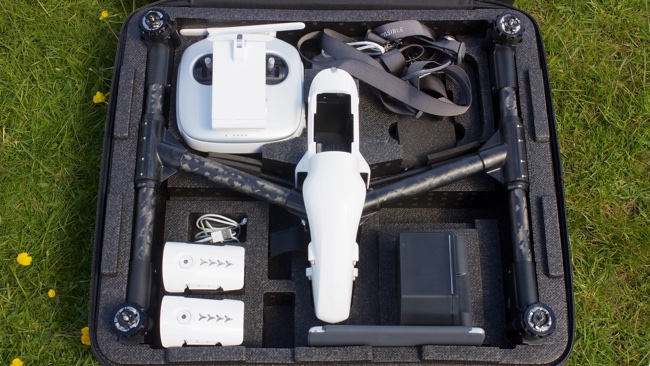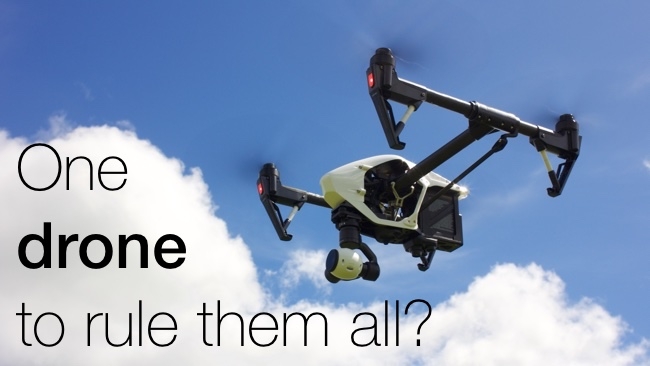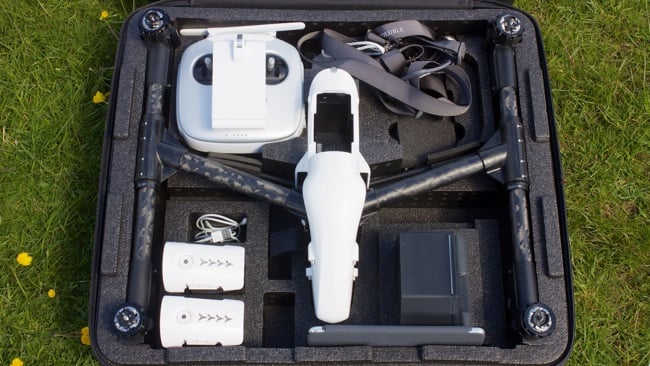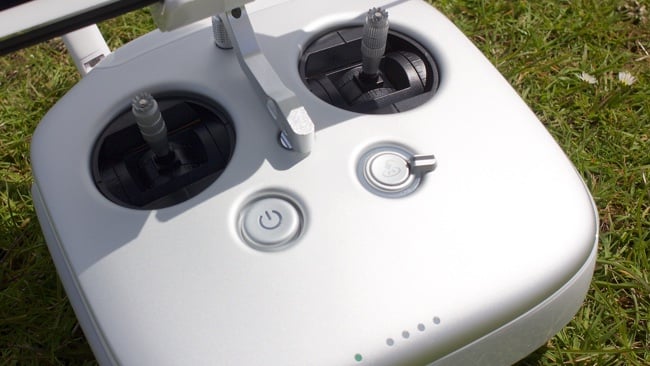
 is the Inspire 1 really that good?
is the Inspire 1 really that good?
In the first of a major two-part review, Simon Wyndham unboxes his brand-new DJI Inspire 1 UAV and gets it ready for take-off.
(Just in case you want to skip ahead to the flying part, the second installment of Simon's review is here.)
Unless you have been on a different planet you cannot have failed to have noticed the proliferation of DJI multi-rotor aircraft. Even people who are not involved in video production will be familiar with the shape of the ever-popular Phantom.
DJI took a gadget that until then would have required self building and soldering along with many other complex procedures, and turned it into something that is accessible to everyone.
The Phantom with its stabilised cameras was a technology enabler. Putting the ability to take fully stabilised aerial footage into the hands of everyone for a relatively modest price was an earth shattering move.
That the Phantom would be appropriated by professional users was inevitable. The Phantom enabled a lot of companies to offer new services and expand their repertoire. But with its fixed landing gear and other limitations it didn't suit all situations. DJI sought to respond to these restrictions and the Inspire 1 seeks to solve many of the issues of the Phantom and then some, making for a platform that can more readily be used in professional applications - albiet at a significantly higher price (currently around the £2300 mark).
Box of delights

The first thing that strikes you about the Inspire 1 is that DJI has included packaging that you well and truly keep in the form of a semi-hard carry case.
This is a full-sized zip up protective case that holds the Inspire 1 UAV along with the supplied accessories. There are cutouts to house an additional transmitter and a total of six batteries, and it will save users money by not having to fork out for a custom cutout Pelicase (although a Pelicase may still be a wise option — the supplied case would not survive the rigours of airport transportation for instance, and it isn't waterproofed).
The base package comes with the UAV itself, a single battery (giving 18 mins flight time), transmitter, transmitter body harness, charger, USB cables, 4K camera & gimbal, ND filter, and a set of propellors along with a full set of spares.
At a size of 438 x 451mm it isn’t as compact as the Phantom, but it is still fairly portable with a light weight of 2935g.
Initial procedures
The Inspire 1 isn’t a toy. It becomes apparent just how in depth it will be when you start to read the full instructions. However, the first thing that I did was to charge up both the main 6 cell UAV battery along with the transmitter.
The charger supplied with the Inspire 1 is capable of being plugged into the main battery and the transmitter simultaneously. I did this without issue, and DJI's own instruction videos tell you to do this. However DJI's instruction manuals recommend against this due to the risk of overheating the charger. Which is correct? I have yet to obtain a definitive answer.
The batteries for the Inspire will take around 1.5hrs to charge from empty, while the transmitter batteries can take up to 6hrs. It may be worth investing in an extra charger or two!
The supplied charger is not a balance charger. All the safety electronics are contained within the battery itself. I like DJI’s approach to this. LiPo batteries have been known to be unstable when not charged or handled correctly, and most of the large batteries that power the big bespoke multi-rotors are still just relatively unprotected chemicals waiting to explode. Safety electronics such as this are very welcome even though it makes the batteries more pricey.
There are other safety features. The battery will not allow itself to be charged in certain temperatures for instance. The battery also logs cell condition so you can always check on its performance, and therefore know when it is time for a replacement.
Firmware updates
Once the batteries had charged there was another important task, and that was to update the firmware. This is a simple affair: simply download the firmware update from the DJI website and then copy the resulting file over to the supplied MicroSD card. Insert this into the Inspire camera and power the aircraft up without the transmitter on.
I did make one cock up and that was to forget to take the craft out of travel mode. There isn’t enough ground clearance for the camera to be mounted like this, so I had to power up the craft fully with the transmitter on in order to tell it to put the legs into landing mode.
Once done and I had attached the camera the update then takes around 25 minutes. Success is indicated by a change in the tone rhythm emanating from the camera. I am used to devices turning themselves off or rebooting after a successful firmware update. This doesn't happen with the Inspire. Once I had plucked up the courage to turn it off I could then check the card on a computer wherein a new text file is written with the words “Success” to indicate a successful firmware update.
It should be noted that when the Inspire 1 firmware is loaded the battery firmware is also updated. As such DJI recommend leaving the .bin file on the card permanently so that any different batteries that you use can automatically be updated if need be.
The drawback of doing this is that each time you turn the Inspire on a new text file is written stating that a firmware upgrade is not needed. After a while you could end up with a lot of these clogging up the card. Not to mention the fact that if you format the card within the Inspire it will erase the firmware file.
Afterwards you then use the same file to update the firmware on the transmitter. This involved plugging in the SD card with a USB card reader and took around 10 minutes to do.
A look at the transmitter

The Inspire 1 transmitter is a wonderful looking piece of gear. Finished in a matte silver with stylish curves, it could have been designed by Apple. It comes complete with an adjustable mobile device holder to hold a smartphone or tablet to run the Pilot app software on.
The rear of the transmitter shows the range of connectivity that is possible. There are two USB ports (full size and micro), HDMI, and a CAN-BUS port. Although quite what is planned for the latter is subject to speculation.
At the top of the unit there are control wheels for function selection, recording, and taking stills, as well as a wheel for controlling tilt pitch of the camera for single operators.
Underneath are two customisable buttons that are configured within the DJI Pilot app, and on top there are buttons to enable Return To Home and to control the retractable prop outriggers/undercarriage. There is also a clip point for the body harness to attach to to support it in front of the operator during use.
While the transmitter does take a long time (6 hrs) to charge up fully, DJI claims that it can be used for 4hrs before needing another charge. The batteries are integrated into the unit and so cannot be changed. There is a clear indication of power by way of bright LED lights at the bottom of the unit.
I do have some concerns about having a non-removable LiPo battery in the transmitter. The cell condition cannot be monitored, and when the cells finally deteriorate it will require a full transmitter replacement. At £500 odd each they are not cheap! So treat your transmitter batteries with the same respect that you show the main UAV ones.
Build quality and attaching bits
Considering its size the craft is fairly light to hold. The main body is constructed from plastic and carbon fibre propeller outriggers. The unit feels solidly constructed. I have seen deconstructions of DJI products before which indicate that these craft are wired to a very high standard compared with some rivals.
When the Inspire 1 was first released it utilised screw on self-tightening propellors. Unfortunately these tended to have a habit of coming off under hard de-acceleration. DJI released a fix for this in the form of plastic prop locks, but a longer term solution was necessary. Now all new Inspire 1s come with a bayonet style locking mechanism for the propellors.
These are nice and quick to attach and to detach, although I have been told to be careful not to force them on too hard as some sheering has been reported by some. This is puzzling because they go on pretty easily and do not generally require any force to attach or to take off.
Another aspect that was drawn to my attention was that the propellers that come with the Inspire are not always perfectly balanced. Something to be mindful of.
DJI Pilot App
The Inspire 1 has been designed to obtain a lot of functionality from the DJI Pilot app. This is available now for free on both iOS and Android systems. You will need at least a system running iOS 8 or Android 4.1.2 and later. For iOS devices you will need at least an iPhone 5s or an iPad Mini 2.
It is essential that you own a compatible device because many vital functions are controlled from the Pilot app such as compass and IMU calibrations. The app also logs flights and shows you all the telemetry information that you require such as speed, altitude, precise battery levels etc. The app is essential for seeing your compass direction and your geographic location.
The Pilot app currently doesn’t have the functionality of the DJI's alternative Ground Station software, which is available for use with the Phantom 3. This software allows control over waypoints for instance. However DJI has said that these capabilities will be coming to the Inspire 1 soon.
Pilot has one other vital function. Simulator mode. Bizarrely this requires the Inspire itself to be powered up, but by using it you can fly a virtual model on your tablet using the main transmitter. This is an absolutely superb way to practice flying. It also allows the user to become familiar with the procedures of flying as well as the functionality of the aircraft. A word of note however, simulator mode is currently only available on the iOS versions of the app.
In use it is remarkable how close the virtual Inspire 1 is to real life. If you haven’t had much practice then it is invaluable. The inclusion of the simulator means that you can practice flying no matter the weather.
The camera
Currently the Inspire 1 camera can shoot up to 4K resolution at 30fps, or up to 60fps at HD resolution. It utilises the same base CMOS chip as the one found in the GoPro Hero 4, and so theoretically at least the image quality should be similar, all things being equal. But they aren't.
The Inspire 1 camera has one advantage over the GoPro, and that is its optics. The GoPro is designed for a varied range of uses, and as such it is configured for a very wide angle of view resulting in the familiar fish eye look. The Inspire’s camera is designed specifically for aerial work, and as such the field of view is limited to 90 degrees with none of the distortion associated with GoPro.
The camera is part of an all in one three-axis gimbal and integrated recording system. The whole thing is removable and has been designed with upgradeability in mind. This means that they can release different camera types for the craft. Because the recording system is inside the camera assembly, this also means that perhaps better perhaps codecs can be implemented in later releases.
Stills can currently be taken in DNG raw format at up to 12MP resolution, while video can be recorded as H264 compression. Digital edge enhancement can be adjusted, as well as shutter speed, ISO, and gamma types, including a LOG option.
Tags: Production


Comments